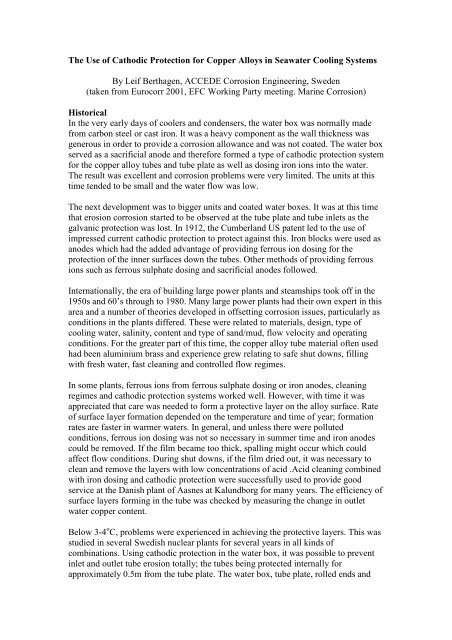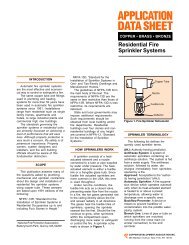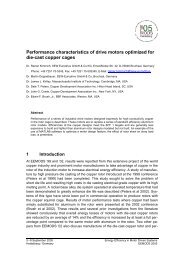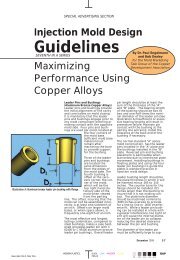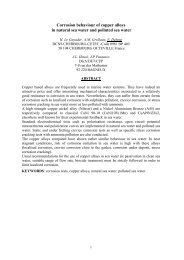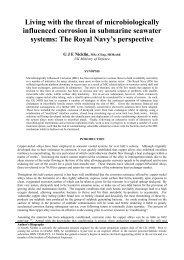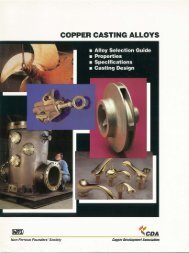Leif _rev3 - Copper Development Association
Leif _rev3 - Copper Development Association
Leif _rev3 - Copper Development Association
Create successful ePaper yourself
Turn your PDF publications into a flip-book with our unique Google optimized e-Paper software.
The Use of Cathodic Protection for <strong>Copper</strong> Alloys in Seawater Cooling SystemsBy <strong>Leif</strong> Berthagen, ACCEDE Corrosion Engineering, Sweden(taken from Eurocorr 2001, EFC Working Party meeting. Marine Corrosion)HistoricalIn the very early days of coolers and condensers, the water box was normally madefrom carbon steel or cast iron. It was a heavy component as the wall thickness wasgenerous in order to provide a corrosion allowance and was not coated. The water boxserved as a sacrificial anode and therefore formed a type of cathodic protection systemfor the copper alloy tubes and tube plate as well as dosing iron ions into the water.The result was excellent and corrosion problems were very limited. The units at thistime tended to be small and the water flow was low.The next development was to bigger units and coated water boxes. It was at this timethat erosion corrosion started to be observed at the tube plate and tube inlets as thegalvanic protection was lost. In 1912, the Cumberland US patent led to the use ofimpressed current cathodic protection to protect against this. Iron blocks were used asanodes which had the added advantage of providing ferrous ion dosing for theprotection of the inner surfaces down the tubes. Other methods of providing ferrousions such as ferrous sulphate dosing and sacrificial anodes followed.Internationally, the era of building large power plants and steamships took off in the1950s and 60’s through to 1980. Many large power plants had their own expert in thisarea and a number of theories developed in offsetting corrosion issues, particularly asconditions in the plants differed. These were related to materials, design, type ofcooling water, salinity, content and type of sand/mud, flow velocity and operatingconditions. For the greater part of this time, the copper alloy tube material often usedhad been aluminium brass and experience grew relating to safe shut downs, fillingwith fresh water, fast cleaning and controlled flow regimes.In some plants, ferrous ions from ferrous sulphate dosing or iron anodes, cleaningregimes and cathodic protection systems worked well. However, with time it wasappreciated that care was needed to form a protective layer on the alloy surface. Rateof surface layer formation depended on the temperature and time of year; formationrates are faster in warmer waters. In general, and unless there were pollutedconditions, ferrous ion dosing was not so necessary in summer time and iron anodescould be removed. If the film became too thick, spalling might occur which couldaffect flow conditions. During shut downs, if the film dried out, it was necessary toclean and remove the layers with low concentrations of acid .Acid cleaning combinedwith iron dosing and cathodic protection were successfully used to provide goodservice at the Danish plant of Aasnes at Kalundborg for many years. The efficiency ofsurface layers forming in the tube was checked by measuring the change in outletwater copper content.Below 3-4 o C, problems were experienced in achieving the protective layers. This wasstudied in several Swedish nuclear plants for several years in all kinds ofcombinations. Using cathodic protection in the water box, it was possible to preventinlet and outlet tube erosion totally; the tubes being protected internally forapproximately 0.5m from the tube plate. The water box, tube plate, rolled ends and
inlet and outlet lengths of tube were successfully protected. The longer tube lengths ofaround 10m needed to form the protective layer and this was difficult for aluminiumbrass in Scandinavia in wintertime and was eventually solved by changing material.Today, condensers and cooling systems still use a lot of copper alloys for shippingand offshore oil/gas production because of cost and also advantages relating tobiofouling resistance. The design advantages related to heat transmission can also beimportant. From around 1990, copper-nickels became more widely used for condensertubing. Ferrous ions are not so necessary for copper-nickel as aluminium brass. Often,it is sufficient for impressed current cathodic protection (ICCP) and iron anodes to beused in the inlet water and inert anodes only in the turn chamber and outlet water box.Such combinations have been used for a large number of installations with very goodresults.CleaningCleaning is always important for optimising heat transfer whatever the materialcombinations used. Today, even if sophisticated automatic pressure regulated filtersare available, they might not be used for smaller installations or sufficient filteringmight not be carried out. In some cases, it is necessary to employ additionalantifouling measures, such as copper ion dosing, as biofouling can be compromised incopper alloys by applying cathodic protection. Particular problems arise if larger sizesof shells get stuck in the system, collect silt, and block the tubes causing turbulentflow and corrosion.For larger power plants as opposed to shipping, a ball cleaning system is often usedfor regular tube cleaning. In the past, soft balls with a layer of carborundum were usedwhich quickly scratched the aluminium brass surface. Today, too, sometimes heavymanual cleaning with metal brushes are used and cause problems. Soft nylon brusheswould normally be preferred instead. Automatic brush cleaning systems are availablebut often the work is performed using manual brushes and pressurised water and air. Itis important to adhere to instructions given by the heat exchanger or system supplieras well as methods used for cleaning, and that these are specific to the actual tubematerial to be cleaned.Material <strong>Development</strong>s and ProtectionMaterials and alloys have been developed and their performance improved over theyears. Tube materials have changed from copper to aluminium brass to copper-nickelalloys whereas the stainless steels have changed to higher alloyed alternatives.Titanium is now used as well. The materials have advantages and disadvantages andthey all have a place in achieving technical and economical solutions.Cathodic protection of stainless steels or copper-nickel with ICCP can work very well.Both materials are easy to protect by applying cathodic current and, with clean surfaceconditions, only a minor negative polarisation is required to achieve protection (ie 50-100mV for stainless and even less for copper-nickel). It is more important with lowergrades of stainless steels to have a surface which is clean and free from marine foulingthan for copper-nickel. In general, the current distribution and potential influence canreach further into stainless steel tubes due to the better oxide resistance than forcopper alloys. Nevertheless good protection results have been achieved for coppernickeltubes.
For copper-nickels, it not always necessary, unless the waters are cold or polluted, tohave additional ferrous ions in the sea water to provide protection; it is often used as acarry over from aluminium brass practice. If used, it is important to keep theprotective layer as thin as possible to reach the optimum corrosion protection and thisis good for heat transfer too. Warmer water (> 15-20 o C) might cause an excessive flocin ordinary sea water, ferrous additions are normally unnecessary as the material willreadily form a protective layer anyway and will show good corrosion resistancenaturally. The addition of an ICCP system will protect the water box and tube platefrom galvanic corrosion or deposit corrosion and the inlet and outlet ends of the tubesfrom turbulence or erosion corrosion caused by localised high flow rates. Evaluationsby electrochemical means are not so straight forward or as well understood withcopper alloys as with stainless steel as the protective film formations are different andthe two cannot be compared. Any future development of alternative short termmethods of evaluation suitable for copper alloys to predict the onset of localisedcorrosion by erosion or sulphides, would be a bonus.Past Cathodic Protection SystemsThe Cumberland US Patent from 1912 was an important development and this type ofcathodic protection combined with electrolytic iron dosing has been used a lot overthe years mostly in condensers with aluminium brass tubing.From 1960-1985, a large number of the systems were supplied for both on-shorepower plants and shipping. Many of the big tankers during this period used steamturbines with large condensers and over a 1000 ships had this type of system. InEurope, they were often known as BERA systems which was an old trade mark of theDanish Bergsoe group. The author was involved over a number of years with thedesign, supply and service of several hundred of these. The older system used ICCPand a rectifier unit that supplied a constant voltage or constant direct current output.To begin with a constant voltage was used but later this changed to a constant current.Both are possible as the sea water resistivity is normally fairly constant. In someapplications, the system was potentiostatically controlled as well which meansreference electrodes are required leading to increased complexity and moreexamination.However, in practice, the use of reference electrodes in ship installations led toproblems of electrode maintenance. Most of the systems supplied had two currentoutput settings; one for normal operations and one for stagnant flow which was about20% of the normal current. Control of the two settings was often by a relay functionwith the main cooling water pump. The reason for reducing the current was to avoidunnecessary consumption of the iron anodes, as well as reducing the amount ofcalcareous deposit caused by too low a cathode potential. These white alkalinedeposits can be high in sea water at low potentials and may even block the tubes. Theiron anodes were designed for 1-2 years life. According to Faraday’s Law, the iron isconsumed at approximately 10 kgs per amp.yr. The normal design “rule of thumb” isthat a direct current output of around 1-3amps/m 2 of tube plate (depending on flowand materials) is required to reach a current density to protect the tube in/outlets fromerosion. For example, for a 1m diameter copper-nickel tube plate, a rectifier with acapacity of 2 amps would be used. As aluminium brass is more sensitive to erosion,copper-nickel can have the lower current density. Normally, this results in a potential
at the tube plate surface of approx. 1V vs. SCE. Over the years, many studies and datacollection were performed on these installations by ABB/BBC, Stal Laval, EPRI andothers 1,2,3,4 .Sacrificial anodes of so called “soft iron” have been used and continue to be so,particularly in rubber lined water boxes with titanium tubing. Experience where theseceased to work were when they were completely insulated with a plastic holder andwhere steel sheet was used which became passivated by corrosion products. On otheroccasions they have been positioned disrupting flow and causing erosion corrosion orturbulence.Impressed Current Cathodic Protection Systems Today.The need for higher water velocities and optimum performance of coolers and theirdesign has influenced material selection. Today, copper-nickel is frequently selectedand the tubes are rolled tight into the tube plate which may itself be clad with coppernickel.In general copper alloys, especially copper-nickel, are very easy to protect bycathodic protection and only a small cathodic polarisation is required; in normalfavourable conditions this would be about 50mV minimum. Cathodic protectionsystems in general are known to be over designed and often too much direct currentoutput is experienced resulting in heavy alkaline deposits which can increase when asystem is stagnant for part of the time. Different methods have been used to solve thisproblem with a variety of success. For more than 10 years an automatic (interrupterpotentiostat) rectifier system has been used in several hundred installations with goodsuccess.A popular automatic rectifier system uses an interrupter potentiostat and a titaniummixed oxide coated (activated) anode. The interruption is controlled to less than amicrosecond and the potential (voltage) is read and recorded. In this way, the titaniumoxide anode acts as a reference electrode without a normal reference electrode beingused. This is possible because the noble oxide* coating/activation layer of thetitanium rod versus the water potential is very stable in the first microseconds. Thismeasurement gives a potential free of voltage (IR) drop. The advantage of this systemis that for periods of stagnant water, the current output is automatically controlled.Contamination and use of special reference electrodes is avoided as well. The anodicreaction of oxygen and chlorine gas evolution keeps the anode surface clean.As these impressed current cathodic protection systems protect the water boxes andtube inlets and outlets, it is still important that efficient cleaning regimes are practicedfor the bulk length of tubes. Even with a cathodic protection system, it is important toclean and keep the surfaces free from mud, deposits and fouling. Formation of theprotective layer, commissioning and standby practices need particular attention.Cathodic protection systems cannot reverse corrosion that has already occurred andoften corrosion of condensers and coolers develops under deposits when the unit isout of operation and perhaps partially empty of water so that the cathodic protectioncannot function properly. In fact, a standby unit can suffer more from corrosion thanwhen the unit is under full flow. Standby systems are normally filled with water withthe cathodic protection system on. The water should be periodically circulated, andreplaced with fresh water at least once every week, or drained down and dried. Each* the type of metal oxide used is dependant on application and whether seawater or brackish water is used.
manufacturer will have their own recommendations and it is important that these arefollowed, especially the procedures for unit start up and shut down.References1.EPRI Report. Effect of Sulfides, Sand, Temperature and Cathodic Protection onCorrosion of Condensers. May 1986, CS-4562 Project 1689-32.EPRI Report. Effect of Selected Water treatments and Cathodic Protection onCorrosion and Embrittlement of Condenser Tubes. Jan. 1988, CS-5589 Project 1689-33 SVF – 36, 1976. The Influence of Ferrous Sulphate Dosage on the resistance of<strong>Copper</strong> alloys to Erosion Corrosion to Baltic Sea water. Henrikson et al.19764. SVF – 18, 1975. Corrosion tests in Baltic Sea water on Heat Exchanger Tubes ofVarious Metallic Materials. Henrikson and Knutsson. 1975


